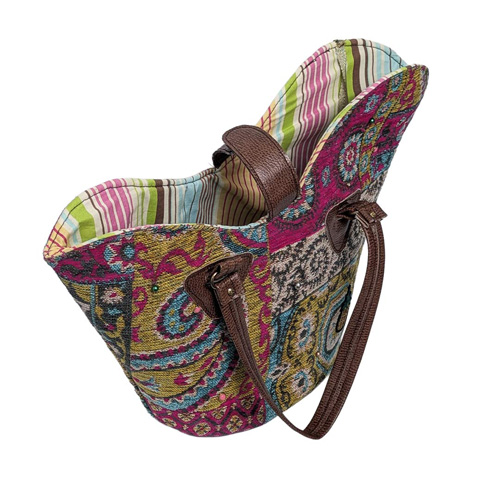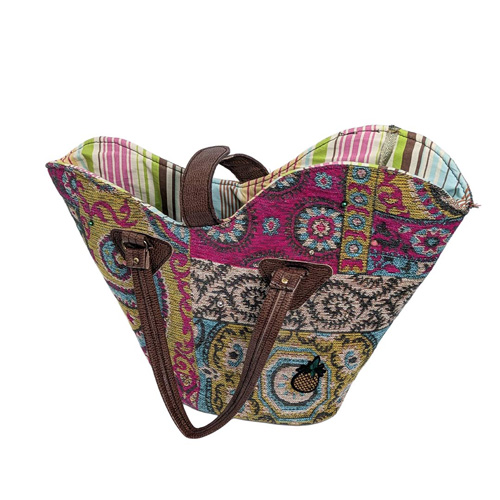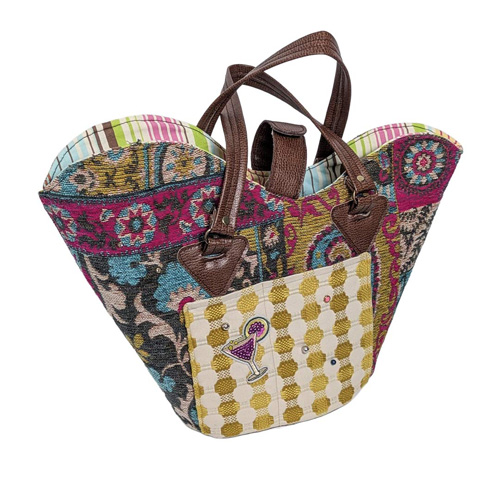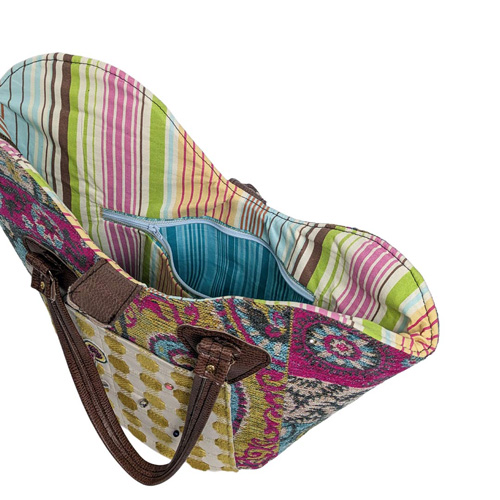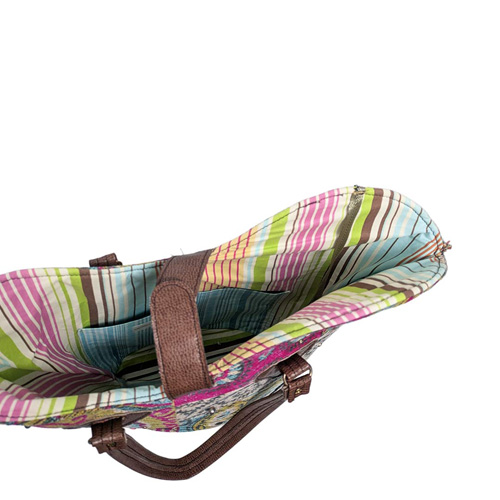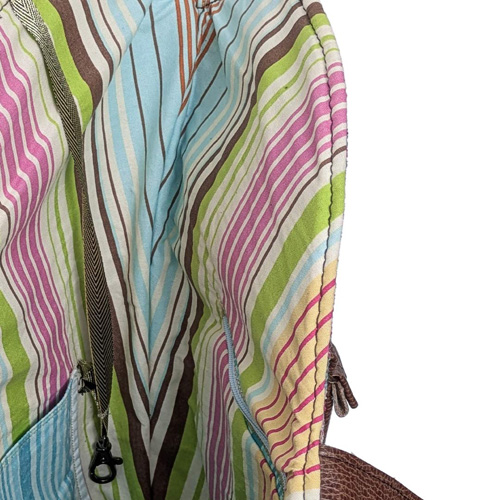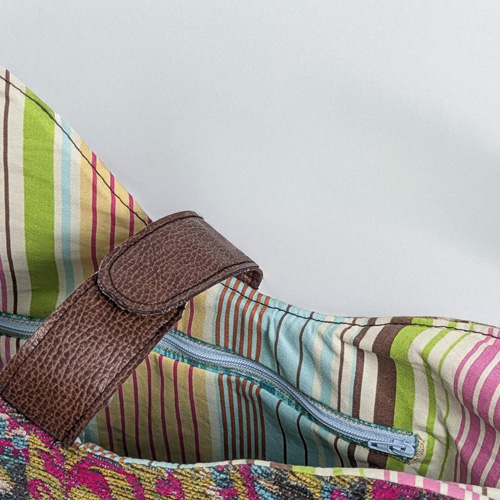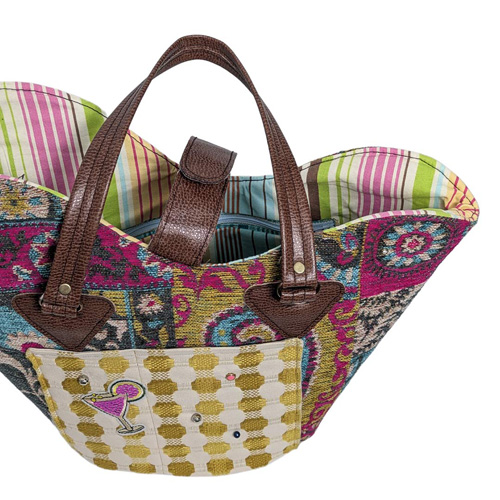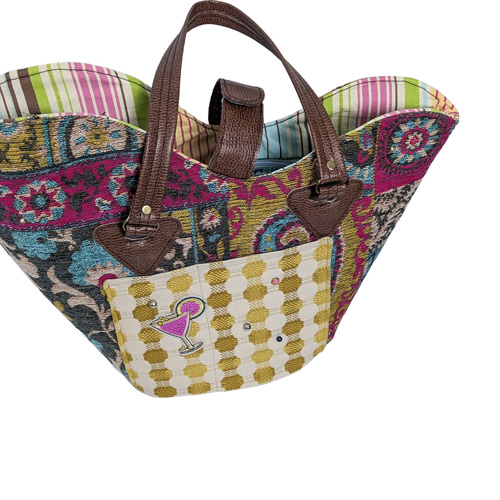Artisan Bags
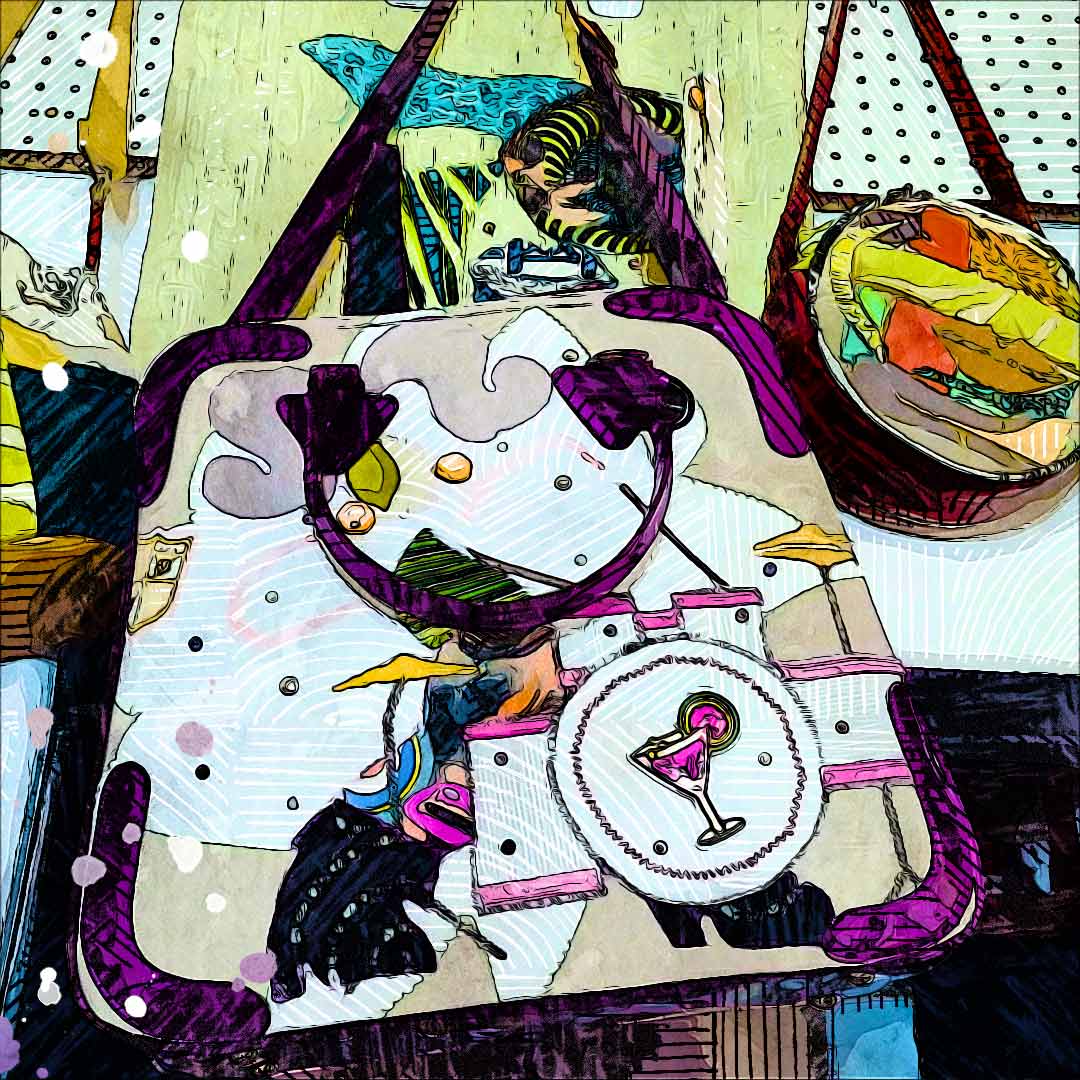
| Height | Width | Depth |
|---|---|---|
| 14″ | 19″ | 9″ |
Unveil your vibrant style with the Tulip Tote, a one-of-a-kind bag that combines bold design with sustainable craftsmanship. Hand-sewn from reclaimed materials and featuring a rich, textured body made from deadstock upholstery fabric, this tote is a true statement piece that reduces waste without sacrificing luxury.
The intricate tapestry exterior features a riot of colors—deep magenta, teal, olive green, and gold—giving it a unique, bohemian flair. Finished with durable, comfortable brown leather handles, this tote is built for everyday life but stylish enough for an evening out.
Material: Reclaimed / Deadstock Upholstery Fabric, Vegan Leather Handles, Cotton Lining
Don’t let the eye-catching exterior distract you from the clever organization inside! This tote is designed to keep your essentials tidy and accessible:
Exterior Pockets: The front features a unique, embellished patch pocket ideal for quick access. It includes:
One Phone Pocket (large enough for most modern smartphones).
One Readers Pocket (perfectly sized for glasses, small sanitizer, or lipstick).
Interior Storage: The spacious main compartment is lined with coordinating cotton and includes multiple features:
One secure Zippered Pocket for valuables.
One open Envelope Pocket for notes or receipts.
A convenient Key Fob Holder to keep your keys exactly where you need them.
Why Artisan Bags Represent a Superior Investment
Choosing to purchase a handmade, artisan bag represents a conscious ethical, environmental, and economic decision that yields significant, long-term benefits for the consumer, the individual maker, and the planet as a whole.
Uncompromising Durability and Long-Term Value
In stark contrast to many mass-market bags, which are often produced with a deliberate, built-in obsolescence to encourage constant repurchase, artisan bags are engineered specifically for longevity and enduring performance. The maker’s entire personal reputation and business sustainability are directly tied to the superior quality of the final product.
This dedication translates into the consistent use of the best available materials, heavily reinforced critical seams, and meticulous, hands-on quality checks at every single stage of production. This unwavering focus on long-term wear means the consumer is replacing their bag far less often, naturally decreasing their personal rate of consumption and thereby reducing demand for new manufacturing. The initial cost may be higher, but the cost-per-wear over the bag’s lifespan is significantly lower.
Artisan Bags: Where Craft Meets Conscience in the World of Wearable Accessories
Handmade, artisan-crafted bags—encompassing a wide spectrum including totes, sophisticated handbags, specialized purses, and durable backpacks—stand as a profound counterpoint to the industrialized, fast-fashion accessories market.
These creations ascend beyond mere utilitarian objects to become genuine pieces of wearable art, distinguished by their singular focus on quality, bespoke design, and ethical production methodologies.
In sharp contrast to mass-produced bags, which are conceptualized to align with ephemeral trends and are manufactured through highly automated assembly lines, artisan bags are defined by the profound intentionality of their maker, the inherent warmth of meticulously handcrafted details, and the palpable, rich narrative embedded within the materials themselves.
The act of creation is slow, deliberate, and deeply personal, instilling the final product with a soul that manufactured items often lack.
The Craft of Creation: The Methodical Process of Artisan Bag Making
The production journey of an artisan bag is characterized by a slow, methodical pace that is entirely reliant on specialized, skilled labor and the individual vision of the creator. This intensive process starkly contrasts with the high-speed, metrics-driven output of industrial factories.
Design, Patterning, and Material Selection
The genesis of an artisan bag resides in the designer’s core vision, which is meticulously translated into a detailed and often complex pattern. Unlike the standardized, machine-cut industrial templates, these patterns are frequently adjusted and adapted to suit the unique characteristics, textures, and even irregular shapes of the chosen materials, ensuring that every piece of fabric is utilized with maximum efficiency and minimal waste. The maker then commences the precise cutting of the selected materials—which can range from high-grade leather, robust canvas, natural wool, or unique specialized textiles—by hand. This requires absolute precision using rotary cutters and measuring instruments, as structural integrity is paramount; every cut is critical to the final bag’s form, symmetry, and ultimate durability. The selection of materials itself is a curated process, where the maker often prioritizes sourcing from small, responsible suppliers rather than large, anonymous wholesalers.
The Historical Roots of Re-making as Social Rebellion
The fundamental human practice of re-working and re-making clothing originated out of sheer necessity—a pragmatic response to poverty or wartime scarcity, as evidenced during periods like the Great Depression and both World Wars.
However, its transition into a deliberate, powerful cultural and political statement is most vividly traceable to the youth movements of the 20th century.
Here, customized attire was intentionally deployed as a direct challenge to established social norms, mainstream authority, and the rapidly growing monotony of industrial consumer culture. The act of personalizing one’s clothing became synonymous with carving out a unique, self-determined identity.
Detailed and Structural Construction Techniques
Construction necessitates a deep, intimate understanding of material science, textile manipulation, and the mechanics of a professional-grade sewing machine. The process is layered and focuses obsessively on longevity:
- Reinforcement and Structure: The foundational step involves fusing or sewing multiple layers of interfacing, batting, or structural stabilizers into both the lining and the main exterior panels. This critical process is what endows a handmade bag with its signature rigid structure, defined shape, and immense durability, qualities that frequently surpass those of its mass-produced equivalents which often skimp on costly internal materials.
- Precision Stitching: While industrial machines employ high-speed stitching for sheer volume and efficiency, the construction of an artisan bag relies on deliberate, slower stitching using carefully chosen, heavy-duty thread weights. Stress points—most crucially the connection points for handles, straps, and corner seams—are often reinforced with triple-stitching or strategic box-and-cross stitching for maximum, guaranteed strength, ensuring the bag can withstand years of daily use and load.
- High-Quality Hardware Installation: The hardware components—including durable metal zippers, solid brass rings, sturdy buckles, and reliable magnetic snaps—are almost always installed by hand using specialized leatherworking and textile tools. This meticulous installation ensures both superior longevity and a noticeably premium finish, differentiating the artisan product from one using cheaper, disposable plastic or lightweight metal findings.
- Unique Embellishments and Finishing: Many handmade bags are personalized through the inclusion of hand-stitched embellishments, intricate appliqué designs, bespoke screen printing, or detailed embroidery. These additions transform the bag into a unique canvas that carries the maker’s artistic voice. The process concludes with careful finishing touches, such as hand-burnishing leather edges or individually pressing seams. Furthermore, the maker’s signature or a unique batch number is often inscribed, serving as an explicit mark of origin and personal guarantee of quality.
The Narrative of Materials: Dedication to Recycled and Deadstock Fabrics
A profoundly defining characteristic of the contemporary artisan bag market is its deep, growing commitment to sustainable material sourcing, particularly through the utilization of recycled and deadstock materials.
This practice actively integrates an essential ethical and powerful environmental component into the bag’s inherent aesthetic value.
Deadstock Fabrics: Salvaging High Fashion
Deadstock specifically refers to high-quality, perfectly usable, but ultimately discarded fabric. This material is textile that would otherwise be designated as waste and sent to landfills.
It typically originates from textile mills or major luxury fashion houses that have significantly over-ordered materials, or produced fabrics in colors, weights, or prints that were ultimately never integrated into a final, mass-market collection.
Artisan makers actively seek out and purchase these small-batch remnants, providing beautiful, high-quality, and often expensive textiles with a crucial second life. This strategic sourcing approach is fundamentally circular, successfully minimizing the demand for new resource extraction and production while drastically reducing waste, all without compromising the material quality of the finished product.
Upcycled and Found Materials: The Art of Transformation
Artisan bag makers are masters of upcycling, demonstrating an exceptional ability to transform pre-existing, often non-traditional, items into viable and unique functional material:
- Vintage and Found Textiles: Materials with established history, such as vintage wool blankets, sturdy military canvas, discarded denim jeans, or antique woven feed sacks, are carefully disassembled, thoroughly cleaned, and then precisely cut into new panels. This re-use brings an irreplaceable patina—a unique texture, subtle fading, and sense of history—that is impossible to replicate with any newly manufactured fabric.
- Recycled Fibers and Plastics: Conscious manufacturers utilize modern fabrics made from cutting-edge recycled fibers, such as rPET (polyester derived from recycled plastic bottles), or textile scraps that have been industrially shredded and re-spun into new, durable yarn. Even repurposed leather scraps from industrial cutting floors are often pieced together in inventive ways.
- Found Objects as Embellishment: Beyond textiles, the makers integrate found objects. Handles might be meticulously crafted from reclaimed wood or bicycle parts, while closures and external pockets might feature repurposed industrial hardware, adding a distinct, captivating mixed-media element to the final design.
By purposefully centering their production on these reclaimed materials, the artisan bag transcends its role as a mere accessory and becomes a powerful symbol of the anti-fast fashion movement, directly confronting the textile industry’s immense and destructive contribution to global waste and pollution.
Direct Support for Craftsmanship and Sustainable Economies
The purchase of an artisan bag ensures direct financial support to the livelihood of an individual artist, a dedicated studio, or a small collective of skilled craftspeople.
This direct transaction ensures that capital circulates precisely within local, small-scale economies, and crucially, validates the inherent value of human skill, creative labor, and specialized expertise over the highly aggregated profits of large corporate entities.
This support is instrumental in keeping specialized, traditional crafts—such as complex leatherworking, intricate stitching, and traditional weaving techniques—not only alive but thriving against the pressure of industrial automation.
Authentic, Unique Expression and Embedded Narrative
Each artisan bag is, by its very nature, a limited-edition item, and frequently exists as a singular, one-of-a-kind creation. The unique, powerful combination of the material’s history (e.g., the knowledge that the denim originated from discarded 1980s workwear), the highly specific design elements, and the palpable evidence of the maker’s hand ensures that the bag is an original, intimate expression of the wearer’s style and values. The owner possesses a physical connection to the entire creative process and the material’s full lifecycle, offering them a product with a demonstrable, rich narrative rather than one with an anonymous, often unsettling, factory origin.
In essence, the artisan bag is elevated beyond a mere utilitarian carrier; it is an active, conscious investment in enduring quality, profound sustainability, and the undeniable power of human creativity. It is a tactile statement against disposability, favoring heirlooms over throwaway items.

